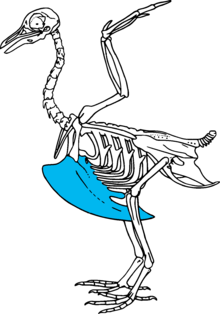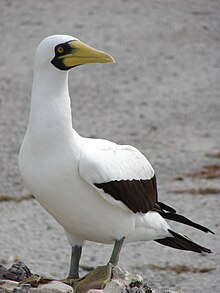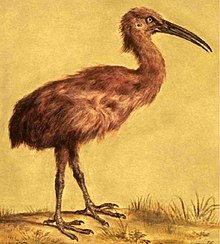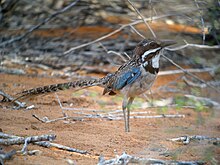Our website is made possible by displaying online advertisements to our visitors.
Please consider supporting us by disabling your ad blocker.
Portal:Birds
The Birds Portal

Birds are a group of warm-blooded vertebrates constituting the class Aves (Latin: [ˈaveːs]), characterised by feathers, toothless beaked jaws, the laying of hard-shelled eggs, a high metabolic rate, a four-chambered heart, and a strong yet lightweight skeleton. Birds live worldwide and range in size from the 5.5 cm (2.2 in) bee hummingbird to the 2.8 m (9 ft 2 in) common ostrich. There are over 11,000 living species and they are split into 44 orders. More than half are passerine or "perching" birds. Birds have wings whose development varies according to species; the only known groups without wings are the extinct moa and elephant birds. Wings, which are modified forelimbs, gave birds the ability to fly, although further evolution has led to the loss of flight in some birds, including ratites, penguins, and diverse endemic island species. The digestive and respiratory systems of birds are also uniquely adapted for flight. Some bird species of aquatic environments, particularly seabirds and some waterbirds, have further evolved for swimming. The study of birds is called ornithology.
Birds are feathered theropod dinosaurs and constitute the only known living dinosaurs. Likewise, birds are considered reptiles in the modern cladistic sense of the term, and their closest living relatives are the crocodilians. Birds are descendants of the primitive avialans (whose members include Archaeopteryx) which first appeared during the Late Jurassic. According to some estimates, modern birds (Neornithes) evolved in the Late Cretaceous or between the Early and Late Cretaceous (100 Ma) and diversified dramatically around the time of the Cretaceous–Paleogene extinction event 66 million years ago, which killed off the pterosaurs and all non-ornithuran dinosaurs.
Many social species preserve knowledge across generations (culture). Birds are social, communicating with visual signals, calls, and songs, and participating in such behaviour as cooperative breeding and hunting, flocking, and mobbing of predators. The vast majority of bird species are socially (but not necessarily sexually) monogamous, usually for one breeding season at a time, sometimes for years, and rarely for life. Other species have breeding systems that are polygynous (one male with many females) or, rarely, polyandrous (one female with many males). Birds produce offspring by laying eggs which are fertilised through sexual reproduction. They are usually laid in a nest and incubated by the parents. Most birds have an extended period of parental care after hatching.
Many species of birds are economically important as food for human consumption and raw material in manufacturing, with domesticated and undomesticated birds being important sources of eggs, meat, and feathers. Songbirds, parrots, and other species are popular as pets. Guano (bird excrement) is harvested for use as a fertiliser. Birds figure throughout human culture. About 120 to 130 species have become extinct due to human activity since the 17th century, and hundreds more before then. Human activity threatens about 1,200 bird species with extinction, though efforts are underway to protect them. Recreational birdwatching is an important part of the ecotourism industry. (Full article...)
Featured articles
Selected general bird topic

A bird hide (blind or bird blind in North America) is a shelter, often camouflaged, that is used to observe wildlife, especially birds, at close quarters. Although hides or hunting blinds were once built chiefly as hunting aids, they are now commonly found in parks and wetlands for the use of birdwatchers, ornithologists and other observers who do not want to disturb wildlife as it is being observed.
A typical bird hide resembles a garden shed, with small openings, shutters, or windows built into at least one side to enable observation. However, because birds do not recognize humans as predatory threats unless the human is standing in the open, a bird blind can be little more than a large shed open on one side in which birders stand, and motor vehicles are effective blinds even with the windows open. (Full article...)
Selected taxon
The order Falconiformes (/fælˈkɒnɪˌfɔːrmiːz/) is represented by the extant family Falconidae (falcons and caracaras) and a handful of enigmatic Paleogene species. Traditionally, the other bird of prey families Cathartidae (New World vultures and condors), Sagittariidae (secretarybird), Pandionidae (ospreys), Accipitridae (hawks) were classified in Falconiformes. A variety of comparative genome analyses published since 2008, however, found that falcons are part of a clade of birds called Australaves, which also includes seriemas, parrots and passerines. Within Australaves falcons are more closely related to the parrot-passerine clade than they are to the seriemas. The hawks, vultures and owls are placed in the clade Afroaves.
The cladogram of the Telluraves shown below is based on the study by Josefin Stiller and collaborators published in 2024. The species numbers are taken from the December 2023 version of the list maintained by Frank Gill, Pamela C. Rasmussen and David Donsker on behalf of the International Ornithological Committee (IOC). This list includes the Cathartiformes (New World vultures) in the order Accipitriformes.
| Telluraves |
| ||||||||||||||||||||||||||||||||||||||||||||||||||||||||||||||||||||||||
The fossil record of Falconiformes sensu stricto is poorly documented. The only stem-falcons that have mostly complete remains are Masillaraptor parvunguis and Danielsraptor phorusrhacoides, while the other taxa Stintonornis mitchelli and Parvulivenator watteli are known from fragmentary remains. Mayr (2009) noted the similarity of Masillaraptor to the seriemas. One study from Wang et al. (2012) using 30 nuclear loci from 28 taxa found Falconidae and Cariamidae being sister taxa to each other. This has, however, not been supported by the latest major neoavian phylogenetic studies. A 2022 study recovers masillaraptorids as true falcons. (Full article...)
Topics
Anatomy: Anatomy • Skeleton • Flight • Eggs • Feathers • Plumage
Evolution and extinction: Evolution • Archaeopteryx • Hybridisation • Late Quaternary prehistoric birds • Fossils • Taxonomy • Extinction
Behaviour: Singing • Intelligence • Migration • Reproduction • Nesting • Incubation • Brood parasites
Bird orders: Struthioniformes • Tinamiformes • Anseriformes • Accipitriformes • Galliformes • Gaviiformes • Podicipediformes • Procellariiformes • Sphenisciformes • Pelecaniformes • Ciconiiformes • Phoenicopteriformes • Falconiformes • Gruiformes • Charadriiformes • Pteroclidiformes • Columbiformes • Psittaciformes • Cuculiformes • Strigiformes • Caprimulgiformes • Apodiformes • Coraciiformes • Piciformes • Trogoniformes • Coliiformes • Passeriformes
Bird lists: Families and orders • Lists by region
Birds and humans: Ringing • Ornithology • Bird collections • Birdwatching • Birdfeeding • Conservation • Aviculture
Quotes
| “ | When I see a bird that walks like a duck and swims like a duck
and quacks like a duck, I call that bird a duck. |
” |
Resources
Free online resources:
- SORA: The Searchable Online Research Archive (SORA) has decades worth of archives of the following journals: The Auk, The Condor, Journal of Field Ornithology, North American Bird Bander, Studies in Avian Biology, Pacific Coast Avifauna, and The Wilson Bulletin. Coverage ends around 2000. The ability to search all journals or browse exists on the front page.
- Notornis: The Journal of the Ornithological Society of New Zealand covers New Zealand and the South Pacific.
- New Zealand Journal of Ecology: This journal often publishes bird-related articles. Like Notornis, this journal is concerned with New Zealand and surrounding areas.
- Marine Ornithology: Published by the numerous seabird research groups, Marine Ornithology is specific and goes back many years.
- BirdLife International: The Data Zone has species accounts for every species, although threatened species and some key groups have greater detail with others only having status and evaluation.
- Author Index: This is a good source for binomial authorities for taxoboxes.
There is also Birds of North America, Cornell University's massive project collecting information on every breeding bird in the ABA area. It is available for US$40 a year.
For more sources, including printed sources, see WikiProject Birds.
WikiProjects
Selected images
Selected bird anatomy topic

A keel or carina (pl.: carinae) in bird anatomy is an extension of the sternum (breastbone) which runs axially along the midline of the sternum and extends outward, perpendicular to the plane of the ribs. The keel provides an anchor to which a bird's wing muscles attach, thereby providing adequate leverage for flight. Not all birds have keels; in particular, some flightless birds lack a keel structure. Some flightless birds have a keel, such as the penguin; but in the penguin's case, its wings are too small for its body, so flight would require flapping its wings too fast to be practical.
Historically, the presence or absence of a pronounced keel structure was used as a broad classification of birds into two orders: Carinatae (from carina, "keel"), having a pronounced keel; and ratites (from ratis, "raft" – referring to the flatness of the sternum), having a subtle keel structure or lacking one entirely. However, this classification has become disused as evolutionary studies have shown that many flightless birds have evolved from flighted birds. (Full article...)
Selected species
Did you know
- ...that the bar-tailed godwit undertakes the longest non-stop migration flight of any bird?
- ...that the black-rumped flameback is a common woodpecker from South Asia?
- ...that the extinction of the Laysan rail was caused by a US Navy landing craft accidentally breaking free and drifting ashore at Midway Atoll, enabling onboard rats to colonize the islands?
Categories
Related portals
Things you can do
Create requested articles (WikiProject Birds – Article requests):
Do these tasks:
 |
Here are some tasks awaiting attention:
|
More outstanding tasks at the project's cleanup listing, Category:Birds articles needing attention, and Wikipedia:WikiProject Birds/Todo.
Taxonomy of Aves
| Class Aves, divided into superorders, orders, suborders (where indicated), and families. | ||||
|---|---|---|---|---|
|
Associated Wikimedia
The following Wikimedia Foundation sister projects provide more on this subject:
-
Commons
Free media repository -
Wikibooks
Free textbooks and manuals -
Wikidata
Free knowledge base -
Wikinews
Free-content news -
Wikiquote
Collection of quotations -
Wikisource
Free-content library -
Wikispecies
Directory of species -
Wikiversity
Free learning tools -
Wikivoyage
Free travel guide -
Wiktionary
Dictionary and thesaurus
Sources
- ^ Platt, S.; Library of Congress (1993). Respectfully Quoted: A Dictionary of Quotations. Barnes & Noble Books. p. 242. ISBN 978-0-88029-768-4. Retrieved February 7, 2020.
Previous Page Next Page















































































